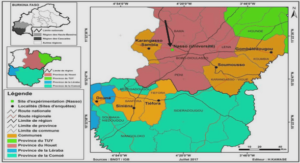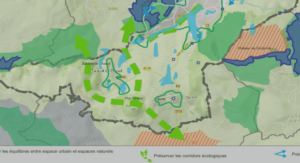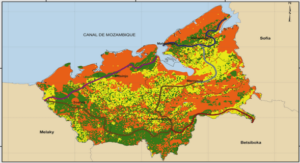Late glacial to deglacial sedimentary
Introduction
One of the peculiar interests of paleoclimatic reconstructions in the high southern latitudes involves the understanding of ice dynamic and ice-sheet behaviour mostly sensitive to temperatures and precipitations variations (Denton and Karlen, 1973; Aniya and Enomoto, 1986). By the way, features of glacial terminations emphasize abrupt changes between glacial and deglacial conditions and provide invaluable informations about the forcing mechanisms of climate changes (Heusser, 1993; Wenzens, 2001). Southern Patagonia exhibits an ideal position to evidence the linkages between mid and high southern latitudes due to its windward location and the position of the two main Patagonian icecaps. Over the last decades a large wealth of studies were focused on the influence of the middle to high latitude climatic regimes and their eventual link with ice cap dynamic (Douglass et al., 2006; Kaplan et al., 2008; Moreno et al., 2009). It has also been proposed that the oulet glaciers represent substantial ice masses continuously fed by heavy rainfall driven by the southern westerlies (SWW) causing high snow accumulation and ice velocities (Roth et al., 1998). Since the last glacial period, Patagonian icecaps have shown evidences of steady fluctuations pace, alternating between advances and retreats phases, based on geomorphological and sedimentological studies and chronological dates on terminal moraines from Southern Patagonian icecap (Aniya and Sato, 1995; Glasser et al., 2004; Kaplan et al., 2005, 2008; Douglass et al., 2005, 2006; Glasser et al., 2008) coupled to modelling of Patagonian extension during the last glacial (Wyrwoll et al., 2000; Hulton et al., 2002). Despite growing consideration on the links between glacier fluctuations and westerly winds, the mechanisms governing these events and their timing remain poorly constrained as well the origin still remains debated. In this study, we present a new sedimentological approach based on a highly resolution terrigenous record by coupling clay mineralogy, grain-size, bulk chemistry, magnetic properties and morphological characteristics of particles from two high sedimentation rate deep-sea cores collected offshore the southern Patagonian area (46°S). The overall aim of this work is to restore southeastern Chilean margin climate variability since the last glacial maximum (LGM) encompassing northern Patagonian icecap fluctuations and their eventual link with regional and global climate. This study benefits of precise AMS 14C and δ18O chronology performed on the planktic foraminifera Globigerina bulloides. The terrigenous record based on extremely high sedimentation rates favours the reconstruction of a detailed dataset that partly solve northern icecap recession/advance timing that varies somewhat between areas, and the impact of climate variability during the last glacial/interglacial transition in the Patagonian region.
Geological and climatic setting
The inland physiography of the study area is characterized by two main geological units from west to east: the Coastal Range and the Andean Cordillera. The Coastal Range is constituted by primarily potassium-rich igneous rocks and low-grade metamorphic basement whereas titanium-rich volcanics build the high reliefs of the Andean Cordillera resulting from the recent activity of the Cenozoic Andean volcanoes overlapping the Patagonian Batholith formed by Mesozoic intermediate plutonic rocks (Stern, 1984; Zeil, 1986). Resulting from the subduction of the Nazca and Antarctic plates beneath the South American plate (Minster et al., 1974; Cande et Leslie, 1986), the strong elevation of the Andes reliefs influence the pattern of the Westerlies-driven rainfall distribution, which are more intense on the western side of the Andes, reaching mean maxima of 3000-4000 mm/yr over the Andes (Miller, 1976; Fujiyoshi et al., 1987; Garreaud et Aceituno, 2007). Offshore, the oceanography is mainly controlled by the cool Antarctic Circumpolar Current (ACC) surface component which converges towards the Chilean coast between 40 and 45°S before splitting up into two branches: the poleward Cap Horn Current (CHC) and the equatorward Humboldt Current (HC; Strub et al., 1998; Fig; 1). Deeper circulation is dominated by the flowing of the Antarctic Intermediate Waters (AAIW) between 400 and 1,200 m depth and the Pacific deep water (PDW) below (Brandhorst et al., 1971). South Patagonian margin is climatically active because of its strategic position that intercepts the entire southern Westerly winds cell (SWW) which exerts a exclusive control on the entrance of storm tracks in the Chilean continent (Trenberth, 1991). Directly dependent of the latitudinal migration of the polar front position, the SWW was submitted to intensity changes and seasonal fluctuations varying from 40 to 60°S resulting in the modification of the distribution of the rainfall, the icefields dynamic and the oceanography.
Material and Methods
Calypso deep-sea cores MD07-3088 and MD07-3119 were collected during the IMAGES PACHIDERME (MD159) cruise on February 2007 by the French R/V Marion Dufresne in the South Pacific Ocean (Kissel, 2007). The first was recovered off the Taitao peninsula (46°04’30S; 75°41’23W; 1,536 m bsl; 18.9 m length) whereas the latter was collected offshore (MD07-3119, 46°05’S, 76°06’W, 3250 m bsl, 32.5 m) (Fig.1). In this study the last 12.9 meters of the MD07-3088 core and the first 7.5 meters for MD07- 3119 core are presented. The lithology of the core MD07-3088 displays predominant greyish olive to grey silty clay deposits with frequent intercalations of silty/sandy layers (Siani et al., 2010). The lithology of the core MD07-3119 is composed of homogenous clayey greyish-olive diatoms-rich layers with some intercalations of silty-sandy layers (Kissel, 2007).
Grain-size measurements
Grain-size analyses were realized on the carbonate-free sediment fraction using a laser diffraction particles analyzer Malvern Mastersizer 2000 at IDES laboratory (Université Paris Sud). -144- Carbonates were removed using 10% HCl solution (Trentesaux et al., 2001) and remaining residual was incorporated in the deionized water tank under 550 rpm for stirrer and 2000 rpm pump conditions. The 12.9 m of the core MD07-3088 were sampled every 2 cm representing 520 samples whereas the core MD07-3119 was sampled every 5 cm representing 109 samples. Each sample was introduced under a beam laser obscuration close to 10%. Mastersizer 2000 mathematical software allowed to obtain distribution parameters and frequencies in respect with Folk and Ward parametric definition (1957) and measurements are expressed between 0.05 and 2,000 mm grain size classes. For the MD07-3088 record, sampling was refined in two coarser layers (i.e. 1368 and 1558 cm) sampled every 0.5 cm at 5 cm on both sides, representing about 24 samples analyzed with a higher beam obscuration of about 15%.
Clay assemblages
Clay mineralogy was acquired by standard X-Ray diffraction (XRD) with a sampling step of 2 cm along the core MD07-3088 that represents 650 samples integrating 130 clay analyses previously determined by Siani et al. (2010) whereas clay minerals were identified every 5cm along the core MD07-3119. Clay signal was performed by X-Ray PANalytical X’Pert Pro MPD diffractometer at IDES laboratory (Université Paris Sud) emitting CuKa dichromatic beam. X-Ray apparatus was adjusted to a goniometer angle of 3 to 30° 2θ range, associated to a beam conditions of 45 KeV and 40 mA and a measuring time of ~ 1 second/step. To remove carbonated fraction, samples were leached in 0.1 N hydrochloric acid solution before to be rinsed several times. Clay mineralogy was performed on the carbonate-free clayey fraction (< 2 μm) extracted from the bulk sediment according to the Stoke’s law before to be mounted on oriented glass slides. Each sample was submitted to three treatments: air drying, ethylene-glycol solvation during 24 hours for each sample and heated at 510°C during 2 hours for few samples. Results are interpreted from semi-quantitative estimations of basal reflections with mean accuracy of approximately 4% and determined from abundance peaks of clay types on glycolated samples using MacDiff software (Petschick et al., 1996). Relative proportions expressed in percentages of the total clay assemblages of smectite and illite are estimated from the areas of the 17Å and 10Å peaks respectively whereas relative proportions of kaolinite and chlorite are calculated from the ratios of areas of the peaks centred at 3.57Å and 3.54Å respectively.
XRF-scanning
Inorganic geochemistry of each carbonate-free sample of the core MD07-3088 were estimated by WDS X-Ray Fluorescence Avaatech core-scanning (XRF) at the Royal Netherland Institute for Sea Research (NIOZ; Richter et al., 2006) and previously presented in Siani et al., 2010. Samples were -145- collected every 1 cm, but in order to facilitate correlations with clay mineralogy data, only results every 2 cm were selected, representing 641 samples. In this study, the most representative elements are presented used as source proxies as K, Ti and Zr elementary contents.
Magnetic grain-size measurements
Paleomagnetic grain-size was performed continuously on the u-channel of the core MD07- 3088 with a sample step of 2 cm. The magnetic parameters (susceptibility, anhysteretic remanent magnetization (ARM) and isothermal remanent magnetization (IRM) have been obtained according to the methods of Weeks et al. (1993; 1995) at the Laboratoire des Sciences du Climat et de l’Environnement (LSCE, Gif sur Yvette, France). Magnetic parameters have been acquired when sedimentary column (u-channel) was submitted to a magnetic field. ARM parameter is performed as a function of the distance of the u-channel from the demagnetizing coils. IRM parameter is acquired when the u-channel passes through the poles of an electromagnet (Weeks et al., 1993). Magnetic susceptibility translates the contribution of ferromagnetic minerals like magnetite and hematite and paramagnetic minerals like olivine, pyroxene and amphibole although ferromagnetic minerals are present in minor proportions compared to the latter (Sandgren and Snowball, 2010).




